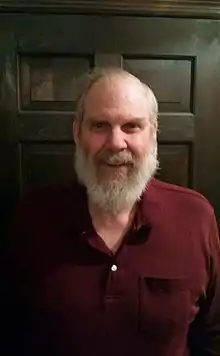Stefan Burr | |
|---|---|
 Burr in 2015 | |
| Born | Stefan Andrus Burr 1940 (age 83–84)[1] |
| Alma mater | University of California, Berkeley (A.B., Mathematics) Princeton University (M.A.; Ph.D. Mathematics, 1969) |
| Known for | Ramsey Theory Number theory |
| Scientific career | |
| Fields | Mathematics and Computer Science |
| Institutions | The City College of New York AT&T Long Lines |
| Doctoral advisor | Bernard Morris Dwork[2] |
Stefan Andrus Burr (born 1940) is a mathematician and computer scientist. He is a retired professor of Computer Science at The City College of New York.
Burr received his Ph.D. in 1969 from Princeton University under the supervision of Bernard Dwork; his thesis research involved the Waring–Goldbach problem in number theory, which concerns the representations of integers as sums of powers of prime numbers.[2]
Many of his subsequent publications involve problems from the field of Ramsey theory. He has published 27 papers with Paul Erdős.[3] The Burr–Erdős conjecture, published as a conjecture by Burr and Erdős in 1975, solved only in 2015, states that sparse graphs have linearly growing Ramsey numbers.
Selected publications
- Burr, Stefan A. (1973). "On uniform elementary estimates of arithmetic sums". Proc. Amer. Math. Soc. 39 (3): 497–502. doi:10.1090/s0002-9939-1973-0314784-8. MR 0314784.
- with P. Erdõs and J. H. Spencer: Burr, S. A.; Erdős, P.; Spencer, J. H. (1975). "Ramsey theorems for multiple copies of graphs". Trans. Amer. Math. Soc. 209: 87–99. doi:10.1090/s0002-9947-1975-0409255-0. MR 0409255.
- with P. Erdõs, R. J. Faudree, C. C. Rousseau and R. H. Schelp: Burr, S. A.; Erdős, P.; Faudree, R. J.; Rousseau, C. C.; Schelp, R. H. (1982). "Ramsey numbers for the pair sparse graph-path or cycle". Trans. Amer. Math. Soc. 269 (2): 501–512. doi:10.1090/s0002-9947-1982-0637704-5. MR 0637704.
References
- ↑ "Burr, Stefan A. (Stefan Andrus) 1940-", WorldCat listing, OCLC WorldCat Identities
- 1 2 Stefan Andrus Burr at the Mathematics Genealogy Project.
- ↑ "Paul Erdős' papers". Alfréd Rényi Institute of Mathematics. Retrieved 25 October 2022.
This article is issued from Wikipedia. The text is licensed under Creative Commons - Attribution - Sharealike. Additional terms may apply for the media files.